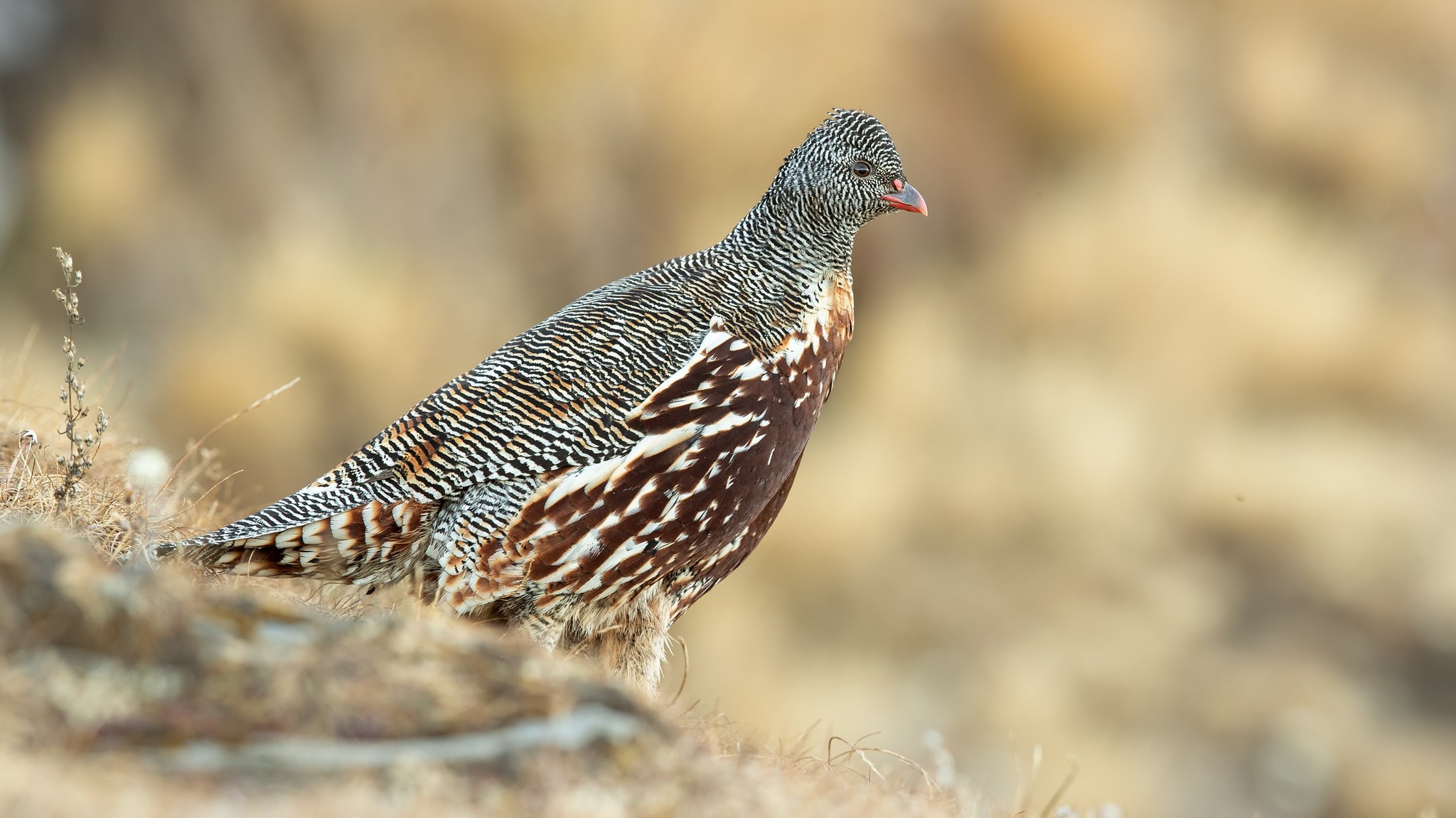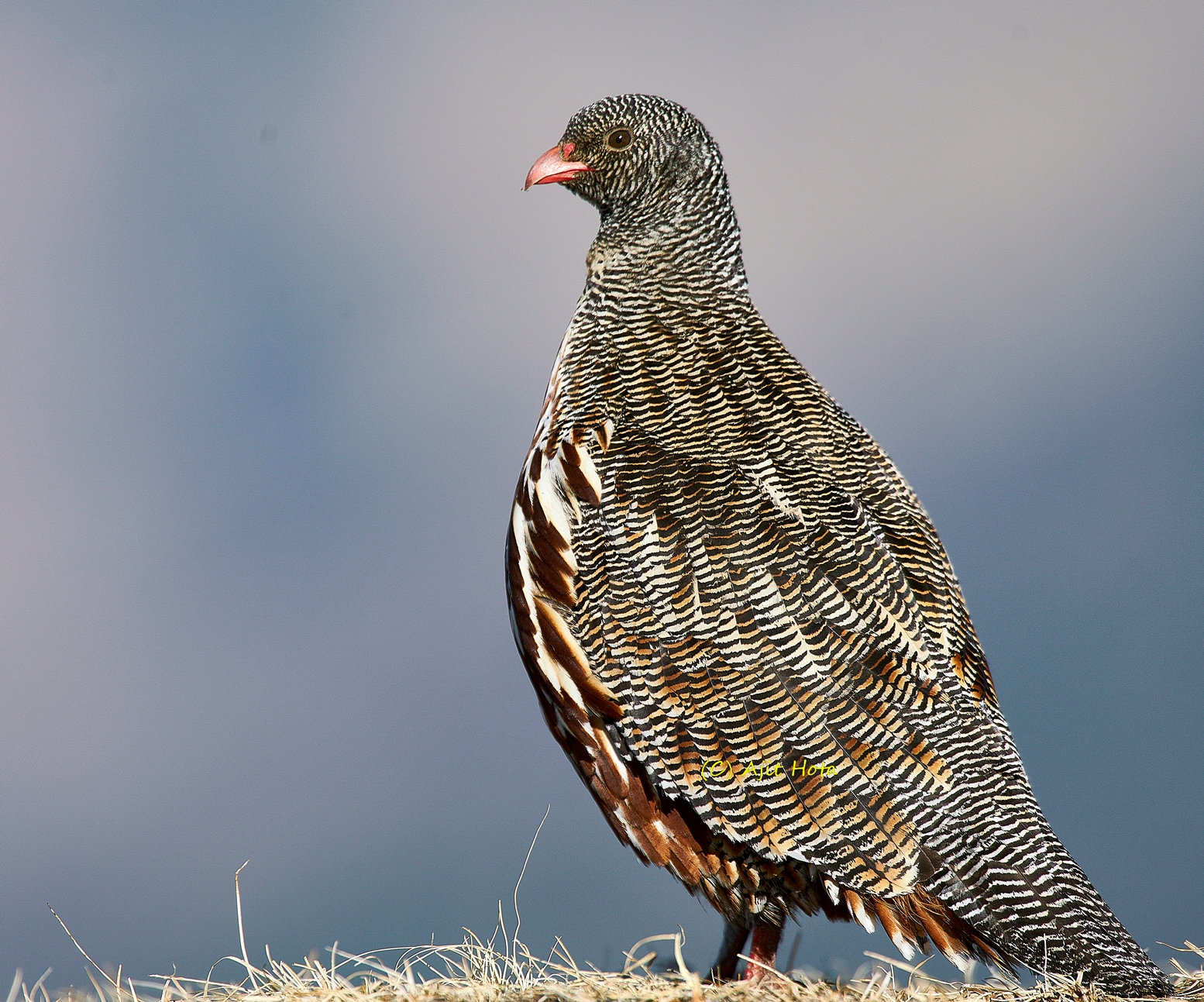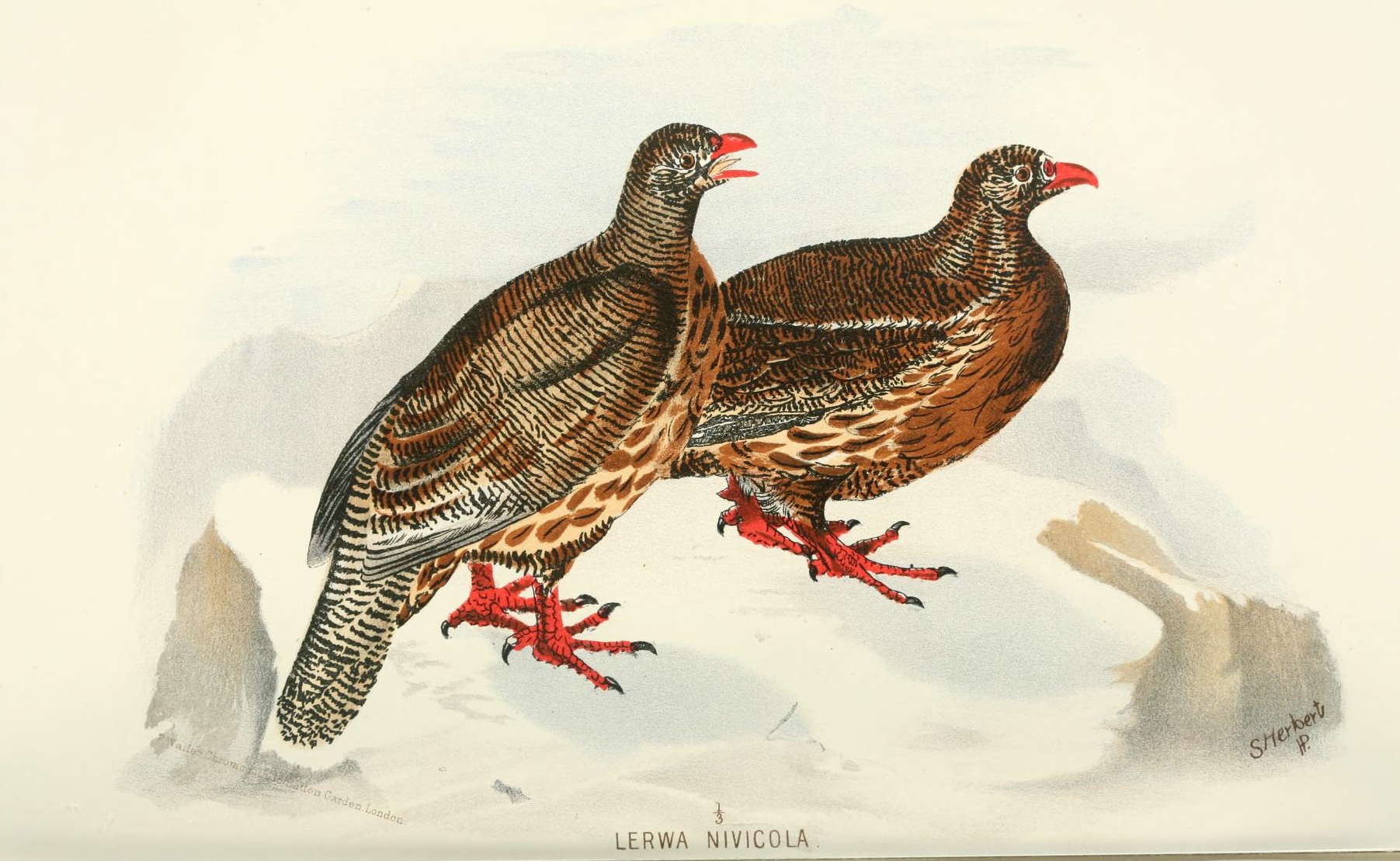Lerwa on:
[Wikipedia]
[Google]
[Amazon]
The snow partridge (''Lerwa lerwa'') is a
 This partridge appears grey above and chestnut below with bright red bill and legs and the upperparts finely barred in black and white. In flight the pattern of dark brown
This partridge appears grey above and chestnut below with bright red bill and legs and the upperparts finely barred in black and white. In flight the pattern of dark brown  It measures 38–40 cm in length. Females weigh 450–580 g; males, 550–700 g. Sexes are similar in plumage, female lacks spurs on the tarsus while the male has a blunt spur and sometimes a second incipient spur. Downy chicks have a resemblance to the chicks of the blood pheasant. Chicks are born with the tarsi feathered and the nostril opening is covered by feathers.
It measures 38–40 cm in length. Females weigh 450–580 g; males, 550–700 g. Sexes are similar in plumage, female lacks spurs on the tarsus while the male has a blunt spur and sometimes a second incipient spur. Downy chicks have a resemblance to the chicks of the blood pheasant. Chicks are born with the tarsi feathered and the nostril opening is covered by feathers.
 This species was first described by
This species was first described by
 Snow partridge is found in the
Snow partridge is found in the
 The snow partridge is found is small groups, usually about 6 to 8 but up to 30 during the non-breeding season. When flushed, they usually fly up before scattering away with noisy wing beats. The flight is rapid and stirring. It has a habit of sunning itself on rocks during the midday. The call in the breeding season is said to resemble that of the
The snow partridge is found is small groups, usually about 6 to 8 but up to 30 during the non-breeding season. When flushed, they usually fly up before scattering away with noisy wing beats. The flight is rapid and stirring. It has a habit of sunning itself on rocks during the midday. The call in the breeding season is said to resemble that of the
Photos, videos
Calls
{{Taxonbar, from=Q833453 snow partridge snow partridge Birds of Afghanistan Birds of the Himalayas Birds of North India Birds of Central China Birds of Tibet Eastern Alpide belt endemic bird species snow partridge Taxa named by Brian Houghton Hodgson
gamebird
Galliformes is an order of heavy-bodied ground-feeding birds that includes turkeys, chickens, quail, and other landfowl. Gallinaceous birds, as they are called, are important in their ecosystems as seed dispersers and predators, and are ofte ...
in the pheasant family Phasianidae
Phasianidae is a family (biology), family of heavy, ground-living birds, which includes pheasants, grouse, partridges, junglefowl, chickens, Turkey bird, turkeys, Old World quail, and peafowl. The family includes many of the most popular Game (hu ...
found widely distributed across the high-altitude Himalaya
The Himalayas, or Himalaya ( ), is a mountain range in Asia, separating the plains of the Indian subcontinent from the Tibetan Plateau. The range has some of the Earth's highest peaks, including the highest, Mount Everest. More than 100 pea ...
n regions of Pakistan
Pakistan, officially the Islamic Republic of Pakistan, is a country in South Asia. It is the List of countries and dependencies by population, fifth-most populous country, with a population of over 241.5 million, having the Islam by country# ...
, China
China, officially the People's Republic of China (PRC), is a country in East Asia. With population of China, a population exceeding 1.4 billion, it is the list of countries by population (United Nations), second-most populous country after ...
, India
India, officially the Republic of India, is a country in South Asia. It is the List of countries and dependencies by area, seventh-largest country by area; the List of countries by population (United Nations), most populous country since ...
and Nepal
Nepal, officially the Federal Democratic Republic of Nepal, is a landlocked country in South Asia. It is mainly situated in the Himalayas, but also includes parts of the Indo-Gangetic Plain. It borders the Tibet Autonomous Region of China Ch ...
. It is the only species within its genus, and is thought to be the most basal member of the "erectile clade" of the subfamily Phasianinae
The Phasianinae (Thomas Horsfield, Horsfield, 1821) are a subfamily (biology), subfamily of the pheasant family (Phasianidae) of landfowl, the order (biology), order Galliformes. The subfamily includes true pheasants, tragopans, grouse, Turkey ( ...
. The species is found in alpine pastures and open hillside above the treeline
The tree line is the edge of a habitat at which trees are capable of growing and beyond which they are not. It is found at high elevations and high latitudes. Beyond the tree line, trees cannot tolerate the environmental conditions (usually low ...
but not in as bare rocky terrain as the Himalayan snowcock
The Himalayan snowcock (''Tetraogallus himalayensis'') is a snowcock in the pheasant family Phasianidae found across the Himalayan ranges and parts of the adjoining Pamir range of Asia. It is found on alpine pastures and on steep rocky cliffs w ...
and is not as wary as that species. Males and females look similar in plumage
Plumage () is a layer of feathers that covers a bird and the pattern, colour, and arrangement of those feathers. The pattern and colours of plumage differ between species and subspecies and may vary with age classes. Within species, there can b ...
but males have a spur on their tarsus.
Description
 This partridge appears grey above and chestnut below with bright red bill and legs and the upperparts finely barred in black and white. In flight the pattern of dark brown
This partridge appears grey above and chestnut below with bright red bill and legs and the upperparts finely barred in black and white. In flight the pattern of dark brown primaries
Primary elections or primaries are elections held to determine which candidates will run in an upcoming general election. In a partisan primary, a political party selects a candidate. Depending on the state and/or party, there may be an "open pri ...
and secondaries with a narrow trailing white margin make them somewhat like the much larger Tibetan snowcock
The Tibetan snowcock (''Tetraogallus tibetanus'') is a bird in the pheasant family Phasianidae of the order Galliformes, gallinaceous birds. This species is found in high-altitude regions of the Western Himalayas and the Tibetan Plateau, where i ...
. The 14-feathered tail is dark and barred in white. There is variation in the shade and some birds have a nearly black crown. The primaries and secondaries are brown and the breast is deep chestnut. The abdomen has more white and the lower flanks and feathers around the vent are barred brown and white. The under-tail coverts are chestnut with black shaft streaks and white tips. Young birds have the lower parts mottled and the barring less distinct. The tarsus is feathered on the front of the leg half-way to the toes.
 It measures 38–40 cm in length. Females weigh 450–580 g; males, 550–700 g. Sexes are similar in plumage, female lacks spurs on the tarsus while the male has a blunt spur and sometimes a second incipient spur. Downy chicks have a resemblance to the chicks of the blood pheasant. Chicks are born with the tarsi feathered and the nostril opening is covered by feathers.
It measures 38–40 cm in length. Females weigh 450–580 g; males, 550–700 g. Sexes are similar in plumage, female lacks spurs on the tarsus while the male has a blunt spur and sometimes a second incipient spur. Downy chicks have a resemblance to the chicks of the blood pheasant. Chicks are born with the tarsi feathered and the nostril opening is covered by feathers.
Taxonomy and systematics
 This species was first described by
This species was first described by Brian Houghton Hodgson
Brian Houghton Hodgson (1 February 1801 – 23 May 1894) was a pioneer natural history, naturalist and ethnologist working in India and Nepal where he was a British Resident (title), Resident. He described numerous species of birds and mammals fr ...
in 1833 and given the genus name ''Lerwa'' based on the Bhutia
The Bhutias (exonym; Nepali: भुटिया, "People from Tibet") or Drejongpas (endonym; , THL: dre-jong pa, "People of the Rice Valley") are a Tibetan ethnic group native to the Indian state of Sikkim who speak Drejongke, a Tibetic ...
name for it in Nepal. Hodgson initially placed it in the genus ''Perdix'' calling it ''Perdix lerwa''. A subspecies, ''L. l. major'' was described by Richard Meinertzhagen
Colonel Richard Meinertzhagen, CBE, DSO (3 March 1878 – 17 June 1967) was a British soldier, intelligence officer, and ornithologist. He had a decorated military career spanning Africa and the Middle East. He was credited with creating an ...
from Sichuan
Sichuan is a province in Southwestern China, occupying the Sichuan Basin and Tibetan Plateau—between the Jinsha River to the west, the Daba Mountains to the north, and the Yunnan–Guizhou Plateau to the south. Its capital city is Cheng ...
while ''L. l. callipygia'' from south Kansu was noted by Stegmann in 1938, but these are not usually recognized. The species has been retained in this monotypic genus due to various peculiarities including the tarsus feathering and the lack of clear sexual dimorphism in plumage. A species of bird louse, ''Chelopistes lervicola'' has been described as an ectoparasite of this species, and other species in this louse genus are known to parasitize the Cracidae, Meleagrididae and Odontophorinae of the New World.
Distribution and status
 Snow partridge is found in the
Snow partridge is found in the Himalayas
The Himalayas, or Himalaya ( ), is a mountain range in Asia, separating the plains of the Indian subcontinent from the Tibetan Plateau. The range has some of the Earth's highest peaks, including the highest, Mount Everest. More than list of h ...
from Pakistan
Pakistan, officially the Islamic Republic of Pakistan, is a country in South Asia. It is the List of countries and dependencies by population, fifth-most populous country, with a population of over 241.5 million, having the Islam by country# ...
to Arunachal Pradesh
Arunachal Pradesh (; ) is a States and union territories of India, state in northeast India. It was formed from the North-East Frontier Agency (NEFA) region, and India declared it as a state on 20 February 1987. Itanagar is its capital and la ...
along the higher ranges, mainly 3000 to 5000 m (rarely below 2000 m) altitude. It is found above the tree line but not on as bare and stony terrain as the snowcocks. Although said to be found in Afghanistan
Afghanistan, officially the Islamic Emirate of Afghanistan, is a landlocked country located at the crossroads of Central Asia and South Asia. It is bordered by Pakistan to the Durand Line, east and south, Iran to the Afghanistan–Iran borde ...
, there is no evidence. The species is found over a large area is generally considered to be of low conservation concern. It is hunted to some extent, due to its habit of being more approachable than snowcock and has declined in population in some areas.
The usual habitat is alpine pastures, open grassy hillsides with grass, lichen
A lichen ( , ) is a hybrid colony (biology), colony of algae or cyanobacteria living symbiotically among hypha, filaments of multiple fungus species, along with yeasts and bacteria embedded in the cortex or "skin", in a mutualism (biology), m ...
s, moss
Mosses are small, non-vascular plant, non-vascular flowerless plants in the taxonomic phylum, division Bryophyta (, ) ''sensu stricto''. Bryophyta (''sensu lato'', Wilhelm Philippe Schimper, Schimp. 1879) may also refer to the parent group bryo ...
, fern
The ferns (Polypodiopsida or Polypodiophyta) are a group of vascular plants (plants with xylem and phloem) that reproduce via spores and have neither seeds nor flowers. They differ from mosses by being vascular, i.e., having specialized tissue ...
s and rhododendron
''Rhododendron'' (; : ''rhododendra'') is a very large genus of about 1,024 species of woody plants in the Ericaceae, heath family (Ericaceae). They can be either evergreen or deciduous. Most species are native to eastern Asia and the Himalayan ...
s. Is found among small snow-patches but not in as stony or bare ground as the snowcock. The birds however are very local in their distribution.
Behaviour and ecology
 The snow partridge is found is small groups, usually about 6 to 8 but up to 30 during the non-breeding season. When flushed, they usually fly up before scattering away with noisy wing beats. The flight is rapid and stirring. It has a habit of sunning itself on rocks during the midday. The call in the breeding season is said to resemble that of the
The snow partridge is found is small groups, usually about 6 to 8 but up to 30 during the non-breeding season. When flushed, they usually fly up before scattering away with noisy wing beats. The flight is rapid and stirring. It has a habit of sunning itself on rocks during the midday. The call in the breeding season is said to resemble that of the grey francolin
The grey francolin (''Ortygornis pondicerianus'') is a species of francolin found in the plains and drier parts of the Indian subcontinent and Iran. This species was formerly also called the grey partridge, not to be confused with the European gr ...
of the plains. It has been compared in habit to that of the ptarmigan. It is said to feed on mosses, lichens, berries, and the shoots of plants. It also swallows grit to aid digestion.
The breeding season is May to July. The males are believed to be monogynous. The nest is a scrape on a hill-side under some sheltering rock, either scratched out by themselves or already available, and usually hidden with vegetation. The nest is sometimes lined with moss but well concealed although given away by the male. About 3 to 5 eggs, pale yellow in color and slightly glossy with reddish-brown markings on the rounded end, are laid, and the female incubates while the male stands sentinel. Parent birds may use distraction display
Distraction displays, also known as diversionary displays, or paratrepsis are antipredator adaptation, anti-predator behaviors used to attract the attention of an enemy away from something, typically the nest or young, that is being protected by a ...
s to draw the attention of predators. They call in a comparatively softer lower note to the young, which respond with chicken-like ''cheep'' calls.
Apart from ''Chelopistes lervicola'' described as an ectoparasite of this species, an Argasid tick ''Argas himalayensis'' has been noted.
References
External links
Photos, videos
Calls
{{Taxonbar, from=Q833453 snow partridge snow partridge Birds of Afghanistan Birds of the Himalayas Birds of North India Birds of Central China Birds of Tibet Eastern Alpide belt endemic bird species snow partridge Taxa named by Brian Houghton Hodgson